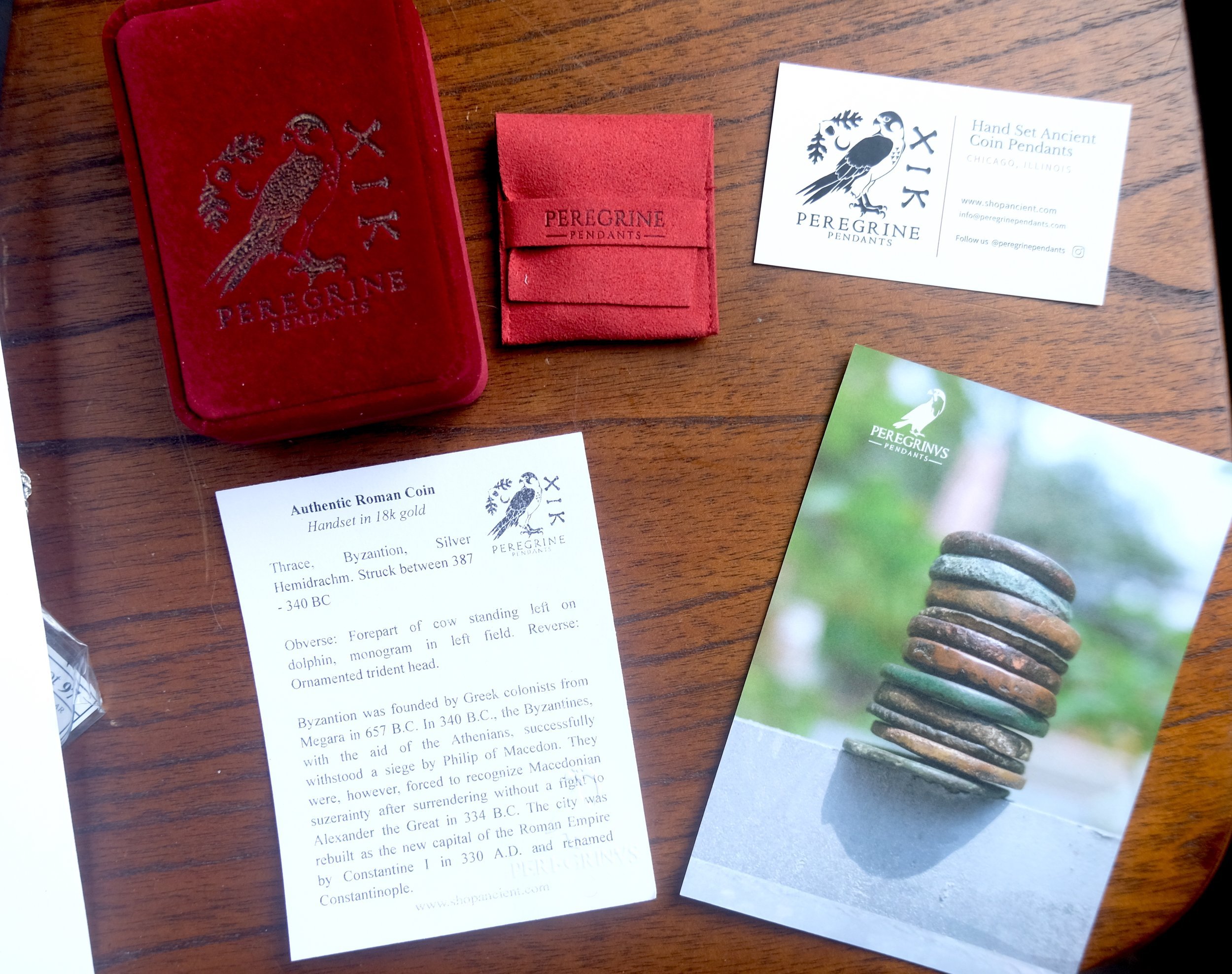 Image 1 of 6
Image 1 of 6

 Image 2 of 6
Image 2 of 6

 Image 3 of 6
Image 3 of 6

 Image 4 of 6
Image 4 of 6

 Image 5 of 6
Image 5 of 6

 Image 6 of 6
Image 6 of 6







Shewolf - Roman Twins Set in 22k
Sex Pompeius Fostlus - Silver denarius
Obverse: helmeted head of Roma right; capis to left, X (mark of value) below chin
Reverse: she-wolf standing right, head left, suckling the twins (Remus and Romulus); to left, shepherd Faustulus standing right; in background, birds on fig tree
Struck 137 BC at Rome Mint
The denarius was the standard Roman silver coin from its introduction in the Second Punic War c. 211 BC to the reign of Gordian III (AD 238–244), when it was gradually replaced by the antoninianus. It continued to be minted in very small quantities, likely for ceremonial purposes, until and through the Tetrarchy (293–313). The word denarius is derived from the Latin dēnī "containing ten", as its value was originally of 10 assēs. The word for "money" descends from it in Italian (denaro), Slovene (denar), Portuguese (dinheiro), and Spanish (dinero). Its name also survives in the dinar currency.
In the Roman foundation myth, a she-wolf (lupa in Italian) was an Italian wolf who nursed and sheltered the twins Romulus and Remus after they were abandoned in the wild by decree of King Amulius of Alba Longa. She cared for the infants at her den, a cave known as the Lupercal, until they were discovered by a shepherd, Faustulus. Romulus would later become the founder and first king of Rome. The image of the she-wolf suckling the twins has been a symbol of Rome since ancient times and is one of the most recognizable icons of ancient mythology.
www.shopancient.com
See all Peregrine Pendants jewelry: https://www.etsy.com/shop/PeregrineAncients
Follow on instagram @peregrinependants
****
Why buy from us? I see a lot of pre-made bezels, that are made for modern coins passing as "handmade" jewelry. Each of our coins is carefully handset in a custom made bezel which takes time and skill.
Sex Pompeius Fostlus - Silver denarius
Obverse: helmeted head of Roma right; capis to left, X (mark of value) below chin
Reverse: she-wolf standing right, head left, suckling the twins (Remus and Romulus); to left, shepherd Faustulus standing right; in background, birds on fig tree
Struck 137 BC at Rome Mint
The denarius was the standard Roman silver coin from its introduction in the Second Punic War c. 211 BC to the reign of Gordian III (AD 238–244), when it was gradually replaced by the antoninianus. It continued to be minted in very small quantities, likely for ceremonial purposes, until and through the Tetrarchy (293–313). The word denarius is derived from the Latin dēnī "containing ten", as its value was originally of 10 assēs. The word for "money" descends from it in Italian (denaro), Slovene (denar), Portuguese (dinheiro), and Spanish (dinero). Its name also survives in the dinar currency.
In the Roman foundation myth, a she-wolf (lupa in Italian) was an Italian wolf who nursed and sheltered the twins Romulus and Remus after they were abandoned in the wild by decree of King Amulius of Alba Longa. She cared for the infants at her den, a cave known as the Lupercal, until they were discovered by a shepherd, Faustulus. Romulus would later become the founder and first king of Rome. The image of the she-wolf suckling the twins has been a symbol of Rome since ancient times and is one of the most recognizable icons of ancient mythology.
www.shopancient.com
See all Peregrine Pendants jewelry: https://www.etsy.com/shop/PeregrineAncients
Follow on instagram @peregrinependants
****
Why buy from us? I see a lot of pre-made bezels, that are made for modern coins passing as "handmade" jewelry. Each of our coins is carefully handset in a custom made bezel which takes time and skill.
Sex Pompeius Fostlus - Silver denarius
Obverse: helmeted head of Roma right; capis to left, X (mark of value) below chin
Reverse: she-wolf standing right, head left, suckling the twins (Remus and Romulus); to left, shepherd Faustulus standing right; in background, birds on fig tree
Struck 137 BC at Rome Mint
The denarius was the standard Roman silver coin from its introduction in the Second Punic War c. 211 BC to the reign of Gordian III (AD 238–244), when it was gradually replaced by the antoninianus. It continued to be minted in very small quantities, likely for ceremonial purposes, until and through the Tetrarchy (293–313). The word denarius is derived from the Latin dēnī "containing ten", as its value was originally of 10 assēs. The word for "money" descends from it in Italian (denaro), Slovene (denar), Portuguese (dinheiro), and Spanish (dinero). Its name also survives in the dinar currency.
In the Roman foundation myth, a she-wolf (lupa in Italian) was an Italian wolf who nursed and sheltered the twins Romulus and Remus after they were abandoned in the wild by decree of King Amulius of Alba Longa. She cared for the infants at her den, a cave known as the Lupercal, until they were discovered by a shepherd, Faustulus. Romulus would later become the founder and first king of Rome. The image of the she-wolf suckling the twins has been a symbol of Rome since ancient times and is one of the most recognizable icons of ancient mythology.
www.shopancient.com
See all Peregrine Pendants jewelry: https://www.etsy.com/shop/PeregrineAncients
Follow on instagram @peregrinependants
****
Why buy from us? I see a lot of pre-made bezels, that are made for modern coins passing as "handmade" jewelry. Each of our coins is carefully handset in a custom made bezel which takes time and skill.
You Might Also Like






















